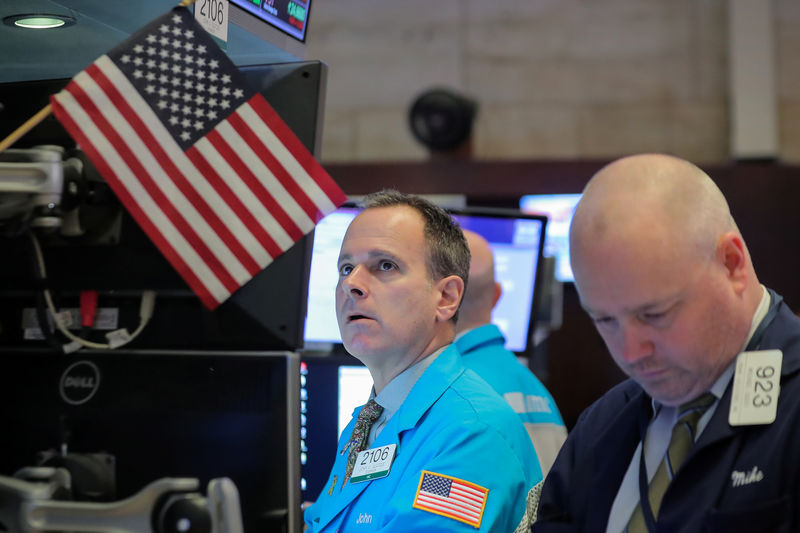By Kate Duguid
NEW YORK (Reuters) - A long-reliable warning signal for stock investors that the tide is about to turn against them briefly flashed caution amid last month's sell-off but does not appear to be calling an end to the bull market just yet.
Like stocks, junk bonds - the high-yielding debt issued by the riskiest corporate borrowers - had a rough October, but nothing close to the magnitude of bloodletting over in equities.
Merrill Lynch's benchmark index for junk bonds fell 1.6 percent last month, its biggest drop since 2016, while the S&P 500 (SPX) sank nearly 7 percent and the Russell 2000 index (RUT) of small stocks plunged 11 percent to mark the poorest monthly performance for both since 2011.
In this cycle, "far from leading the stock market in this downturn, high yield has lagged," said Martin Fridson, chief investment officer at Lehmann, Livian, Fridson Advisors LLC.
Moreover, junk bond yield spreads, or the measure of additional compensation investors demand for owning these risky securities rather than safer bonds like U.S. Treasuries, have not blown out to the degree they have ahead of market downturns in the past.
In 2007, junk spreads began persistently widening nearly five months before stocks began to tumble. By the time it was apparent stocks were headed for their deepest bear market since the Great Depression, junk yields had already mushroomed from around 2.50 percentage points over Treasury yields to 8.60 points. They recorded a similar move in early 2000 before the dot-com bubble burst.
By contrast, junk spreads only widened by less than three-quarters of a percentage point in the recent sell-off, and have tightened again since.
Jeffrey Gundlach, the chief executive of DoubleLine Capital, said one of the reasons not to believe a downturn was imminent is that high-yield spreads have been contained. "I do in fact believe there will be a mass exodus from junk and investment grade, once the next recession hits, and it will be in evidence in a less obvious way before that."
GRAPHIC - U.S. bond sector returns : https://tmsnrt.rs/2CUr9PX
PAIN POINTS
Within junk debt, bonds in sectors particularly vulnerable to recession have been hit hardest.
Home builders and real estate <.MERH0HB>, for example, has recorded its worst performance since September 2014, when the blowout in oil prices began.
The riskiest junk bonds, triple-C rated <.MERH0A3> issues, recorded their worst performance since January 2016, with yields rising more than twice as much as the broader junk index.
"There is some definitive pain in some sectors, which is why this is different from February when we saw a more broad-based sell-off. There are some bonds in energy, auto parts, home builders down 5 to 20 percent, and some of those stocks are down 30 to 40 percent," said William Smith, high yield portfolio manager at AllianceBernstein.
All told, "this is the first time we're starting to see tightening credit conditions," said Jack Ablin, chief investment officer at Cresset Wealth Advisors. With a record number of bonds just barely qualified as investment grade, tighter credit could mean a wave of downgrades into the junk sector. And it's not currently clear whether the junk market is big enough to absorb that much supply.
"Previous downdrafts were simple price corrections," said Ablin. "This could be different if liquidity dries up."
It is possible that some of the credit weakness in the high-yield market has been cushioned by expectations that defaults will be lower or slower than during past downturns because protections for high-yield bond investors - called covenants - are so poor they could stall bankruptcies.
"The speedbumps that are usually in a document that require companies to go back to creditors aren't there," said Evan Friedman, senior vice president at Moody's Investors Service.
"That can delay a default."
The default rate, by comparison, has been improving and that is expected to continue. Moody's Default and Ratings Analytics team forecasts that the United States' trailing 12-month high-yield default rate will sink from 3.06 percent in September 2018 to 2.0 percent in September 2019.
Indeed, for most investors, high yield trailing equities is an indication that a downturn is not yet around the corner.
"It seems that while high yield investors are concerned with the deteriorating credit cycle, they're not ready to call an end yet," said Michael DePalma, chief executive of PhaseCapital LP.

GRAPHIC - Russell 2000 vs BAML U.S. high yield index : https://tmsnrt.rs/2Qx8QEF